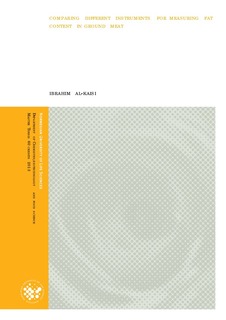| dc.description.abstract | Knowledge of the fat content in the meat is extremely important subject for the food production
industry. Food production’s companies like (STABBURET) can save big amount of money by
determine some quality attributes. Several fast and nondestructive instrumental methods have been
reported, such as use of X-ray, ultraviolet energy, fluorescence, visual light, Raman scatter, infrared
energy, radio waves and few moor.
The first part of this thesis shall discuss the multivariate statistic and the calibration methods. I
obtained two data sets from NOFIMA. These data sets is taken from the NIR instrument Q-vision 500.
In this part I shall try to learn some important principles in modern calibration methods such as PCA,
PCR and PLS.
In the second part of this thesis we will emphasis on some methods that have been used by
STABBURET, AASHEIM KJØTT, ANIMALIA and EUROFINS. These methods are either x-ray, chemical or
Near Infrared Spectroscopic (NIR). One problem with all methods is that we do not get the true value
of the fat content, but a prediction depends on some reference methods. This is the reason we have
different results from different instruments. The background for our study is that STABBURET has
observed some differences in the fat measurements from their instruments (FA DEXA, BUCHI and NIR
INRAALYZER) with the fat content value they get from AASHEIM KJØTT. The people in STABBURET
confirmed that those differences are always over the measurements from AASHEIM KJØTT. That
means, if AASHEIM KJØTT deliver a batch of 800-1000kg grading meat from the category 21% fat
content, the people from the laboratory will find that the fat content is 23% or more. In this way
STABBURET pay for one fat category, but they get meat with higher fat content.
The most important conclusion in my opinion is that the reference instrument (FOODSCAN) at
ANIMALIA is closer to the FA DEXA at STABBURET than Q-monitor at AASHEIM KJØTT. The results
from the first and second data collection show that Q-monitor provides results with lower fat
content than the other instruments. A new recalibration for Q-monitor according to the results from
these two data collection, could improve the performance of this instrument. | no_NO |
